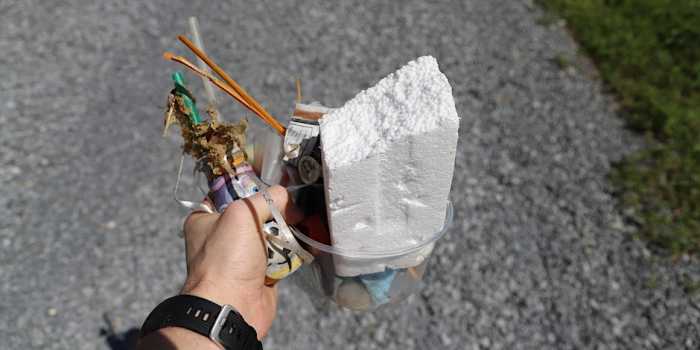Shifting Sands: Olivine Beach Replenishment Material Raises Local Questions

A San Francisco-based company is planning to use olivine, a mineral found overseas that captures carbon dioxide, in East End beach replenishment projects in the first real-world use of the material to fight climate change.
Project Vesta and its affiliates have permits applications pending with the Town of Southampton, Suffolk County, New York State and federal agencies to use olivine, a volcanic rock that is milled into the size of grains of sand, in North Sea and Westhampton Dunes. While the company touts its efforts as a benevolent bid to help stem the climate crisis, environmentalists suggest the project is a money-making scheme. Either way, the work may be weeks away from getting the green light.
“The olivine is this natural mineral … and when it gets into the ocean, it basically acts as an antacid,” said Project Vesta CEO Tom Green. “So it reduces the acidity of the ocean. What it actually does is cause the ocean to take carbon dioxide out of the atmosphere and store it in the water … This is a natural process that has been working on this planet for billions of years. What we’re doing is accelerating the natural process.”
It uses a process called enhanced coastal weathering — the oceanic equivalent of planting trees to remove carbon dioxide from the atmosphere. Project Vesta is also planning a pilot program using the material at a beach in the Dominican Republic and has permits pending in other states nationwide.

“The beauty of this approach — one of many, there’s no silver bullet — is olivine mimics nature,” said Aram Terchunian, owner of Westhampton Beach-based First Coastal Corporation and senior advisor to Project Vesta.
Of course, to knock a dent in climate change, the company would need to place a lot more olivine than just in the Hamptons. Project Vesta hopes to eventually place enough olivine to remove a billion tons of carbon dioxide annually from the atmosphere.
Steve Resler, a retired Department of State coastal manager who has called on the state to adhere to decades-old legal mandates calling for strategic retreat — not rebuilding beach homes that wash away, but building sea walls in lower Manhattan, for example — is skeptical of the plan.
“There’s no olivine anywhere along the eastern seaboard of the North American continent,” he said. “It’s not native to the East Coast’s shorelines and doesn’t belong there. But it is found on upland and in-water areas of (Caribbean) islands and parts of Central America where volcanic materials are still readily accessible. Rape the poor countries and commonwealths for the rich folks back in the USA. And use its alkalinity as a ‘carbon capture’ sales pitch to snoocker dumbass permit review folks into using their lack of knowledge to approve what shouldn’t be approved.”
The state Department of Environmental Conservation reports at least 12 permit applications from individual property owners and First Coastal for what it terms a “living shoreline project” that includes the proposed use of olivine sand.
“DEC is currently reviewing those permits to ensure they meet DEC’s stringent protections of public health and the environment,” the agency said. “The 12 proposals include placing 1,128 cubic yards of sand fill, 10% of which would be olivine sand, in the intertidal area in Westhampton Dunes on Moriches Bay. DEC is actively reviewing all proposals and final project specifics have not been determined at this time.”
Kevin McAllister, the founding president of Sag Harbor-based Defend H20, is concerned with any plans that may interfere with wetlands.
“Having not seen the project applications, I’ll say with a high level of certainty these projects are being sold as ‘living shorelines,’” he said. “A kinder, gentler approach to shoreline hardening. Shore-parallel rock sills constructed in the nearshore to dampen wave energy, and … fill wetlands. … I’ve seen and have opposed enough of the so-called ‘living shoreline’ projects to recognize exactly what’s going on. Property owner/consultant/agency end-around to facilitate wetland filling and shoreline armoring while calling it something else. A wolf in sheep’s clothing is what it is.”
There are additional permits in the works for a beach project on the Peconic Bay in North Sea.
“DEC received a permit modification application from the Town of Southampton … to place 500 cubic yards of olivine sand along 1,200 linear feet of shoreline at North Sea Beach Colony,” the DEC said. “The permit modification was approved.”
The U.S. Army Corps of Engineers was unable to share the status of olivine-related project permits as of press time.
Southampton Town Supervisor Jay Schneiderman said he favors the idea.
“I support the project, provided it’s been fully vetted and supported by environmental regulators,” he said. “I do have a lot of questions relating to the carbon equation. A lot of energy is used to mine, crush and transport the olivine. This batch is from Norway. What is the overall carbon footprint of this project? Is it net positive?”
Green maintains that the olivine captures 20 times more carbon than the project’s footprint. But Resler questions how the company can verify how much carbon the olivine is capturing after it is mixed with sand and placed on a shoreline.
Will this project get the green light and be coming to Hamptons beaches any time soon? Stay tuned.









